Related Research Articles

The Southwest Chief is a long-distance passenger train operated by Amtrak on a 2,265-mile (3,645 km) route between Chicago and Los Angeles through the Midwest and Southwest via Kansas City, Albuquerque, and Flagstaff mostly on the BNSF's Southern Transcon, but branches off between Albuquerque and Kansas City via the Topeka, La Junta, Raton, and Glorieta Subdivision. Amtrak bills the route as one of its most scenic, with views of the Painted Desert and the Red Cliffs of Sedona, as well as the plains of Illinois, Missouri, Kansas, and Colorado.

The Atchison, Topeka and Santa Fe Railway, often referred to as the Santa Fe or AT&SF, was one of the largest Class 1 railroads in the United States between 1859 and 1996.

The Super Chief was one of the named passenger trains and the flagship of the Atchison, Topeka and Santa Fe Railway. The then-modern streamliner was touted in its heyday as "The Train of the Stars" because it often carried celebrities between Chicago, Illinois, and Los Angeles, California.
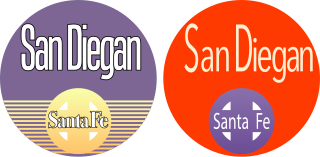
The San Diegan was one of the named passenger trains of the Atchison, Topeka and Santa Fe Railway, and a “workhorse” of the railroad. Its 126-mile (203-kilometer) route ran from Los Angeles, California, south to San Diego. It was assigned train Nos. 70–79.
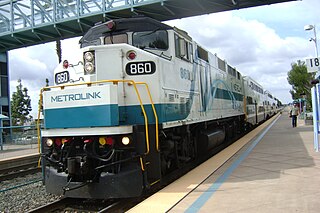
The Orange County Line is a commuter rail line run by Metrolink from Los Angeles through Orange County to Oceanside in San Diego County, connecting with the Coaster commuter rail service to San Diego. The Orange County Line carries passengers to the primary Metrolink hub at L.A. Union Station in downtown Los Angeles, as well as to many attractions in Orange County including the Knott's Berry Farm area, Angel Stadium of Anaheim and the Honda Center, the Disneyland Resort, Old Town Orange, Santa Ana Zoo, Mission San Juan Capistrano and many more. In San Diego County, it serves the Oceanside Pier and Camp Pendelton.
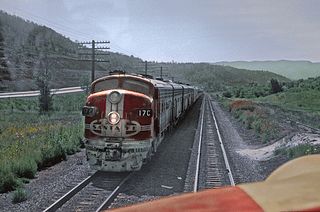
The Chief was an American long-distance named passenger train of the Atchison, Topeka and Santa Fe Railway that ran between Chicago, Illinois and Los Angeles, California. The Santa Fe initiated the Chief in 1926 to supplement the California Limited. In 1936 the Super Chief was introduced, after the Super Chief was relaunched in 1948 with daily departures from LA and Chicago it gradually eclipsed the Chief as the standard bearer of the Santa Fe because of its timetable oriented to the Raton Pass transit. For some the Chief and San Francisco Chief as deluxe integrated trains with both Pullman sleepers and fully reclining coach seating with all facilities; lounges and pleasure domes, available to all passengers were at least equal flagships better suited to the business and executive market. From the mid 1960s the super Chief was only a small entirely separate section of the El Capitan seated vista train, the El Capitan passengers having no access to the Super Chiefs expensive eateries and bars which selling point was exclusion and service. The Chief was discontinued in 1968 due to high operating costs, competition from airlines, and the loss of Postal Office contracts.

The Surf Line is a railroad line that runs from San Diego to Orange County along California's Pacific coast. It was so named because much of the line is near the Pacific Ocean, within less than 100 feet (30 m) in some places. It is the second busiest passenger rail corridor in the United States after the Northeast Corridor.

Atchison, Topeka and Santa Fe 3751 is a preserved class "3751" 4-8-4 "Heavy Mountain" type steam locomotive built in May 1927 by the Baldwin Locomotive Works in Eddystone (Philadelphia), Pennsylvania for the Atchison, Topeka & Santa Fe Railway (ATSF). No. 3751 was the first 4-8-4 steam locomotive built for the Santa Fe and was referenced in documentation as type: "Heavy Mountain", "New Mountain", or "Mountain 4-wheel trailer". No. 3751 served in passenger duties until being retired on August 23, 1953.

The California Limited was one of the named passenger trains of the Atchison, Topeka and Santa Fe Railway. It carried train Nos. 3 & 4 and ran between Chicago, Illinois, and Los Angeles, California.

The Grand Canyon Limited was one of the named passenger trains of the Atchison, Topeka and Santa Fe Railway. It was train Nos. 23 & 24 between Chicago, Illinois, and Los Angeles, California.
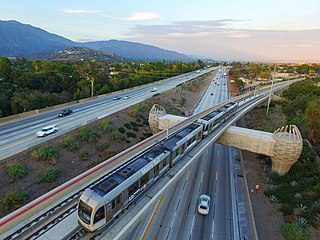
The A Line is a light rail line in Los Angeles County, California. It is one of the six lines of the Los Angeles Metro Rail system, operated by the Los Angeles County Metropolitan Transportation Authority (Metro). The A Line serves 44 stations and runs east-west between Azusa and Pasadena, then north-south between Pasadena and Long Beach, interlining and sharing five stations with the E Line in Downtown Los Angeles. It operates for approximately 19 hours per day with headways of up to 8 minutes during peak hours. It runs for 48.5 miles (78.1 km), making it the world's longest light rail line since 2023.

The Super C was an American high-speed intermodal freight train on the Atchison, Topeka and Santa Fe Railway from 1968 to 1976. Dubbed the "World's Fastest Freight Train," the all-TOFC and COFC (container-on-flatcar) train ran about 2,200 miles (3,500 km) between Chicago, Illinois and Los Angeles, California on a 40-hour schedule.
The Atchison, Topeka and Santa Fe Railway's 3460 class comprised six 4-6-4 "Super Hudson" type steam locomotives built in 1937 by the Baldwin Locomotive Works for service between La Junta, Colorado and Chicago, Illinois, a fairly flat division of the railroad suited for the 4-6-4 type. They were substantially larger than the road's earlier 3450 class locomotives, and all were built oil-fired, although in a manner that would allow for easy conversion to coal firing. All were fitted with SKF roller bearings on every axle.

The Scott Special, also known as the Coyote Special, the Death Valley Coyote or the Death Valley Scotty Special, was a one-time, record-breaking passenger train operated by the Atchison, Topeka and Santa Fe Railway from Los Angeles, California, to Chicago, Illinois, at the request of Walter E. Scott, known as "Death Valley Scotty". At the time of its transit in 1905, the Scott Special made the 2,265-mile (3,645 km) trip between the two cities at the fastest speed recorded to date; in doing so, it established the Santa Fe as the leader in high-speed travel between Chicago and the West Coast. The Scott Special made the trip in 44 hours and 54 minutes breaking the previous records, set in 1900 by the Peacock Special, by 13 hours and 2 minutes, and in 1903 by the Lowe Special, by 7 hours and 55 minutes. Santa Fe's regular passenger service from Los Angeles to Chicago at the time was handled on a 2½-day schedule by the California Limited. It was not until the 1936 introduction of the Super Chief that Santa Fe trains would regularly exceed the speeds seen on the Scott Special.

Walter Edward Perry Scott, also known as Death Valley Scotty, was a prospector, performer, and con man who was made famous by his many scams involving gold mining and the mansion in Death Valley, known as Scotty's Castle.
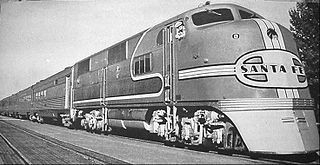
The Golden Gate was one of the named passenger trains of the Atchison, Topeka and Santa Fe Railway. It ran on the railroad's Valley Division between Oakland and Bakersfield, California; its bus connections provided service between San Francisco and Los Angeles via California's San Joaquin Valley.

Santa Fe Depot is a union station in San Diego, California, built by the Atchison, Topeka and Santa Fe Railway to replace the small Victorian-style structure erected in 1887 for the California Southern Railroad Company. The Spanish Colonial Revival style station is listed on the National Register of Historic Places and is a San Diego Historic Landmark. Its architecture, particularly the signature twin domes, is often echoed in the design of modern buildings in downtown San Diego.
David Benton Jones was president and chairman of the board of directors of the Mineral Point Zinc Company and considered a founder of the Zinc industry in America. When ill, he chartered a special train whose speed rivaled the time of the Scott Special.

Arcadia station is an at-grade light rail station on the A Line of the Los Angeles Metro Rail system. It is located at the intersection of 1st Avenue and Santa Clara Street in Arcadia, California, after which the station is named.
References
- ↑ "Another Speed Record Broken".
- ↑ "Zinc Industry Founder Dead...".
- ↑ Wilson 2002, p. 13.
- ↑ "Jones Special Another Notable Santa Fe Run".
{{cite journal}}: Cite journal requires|journal=(help) This article has 3 paragraphs on the Jones Special; 2 paragraphs on the Scott Special; and 1 paragraph each on the Nellie Bly; B. P. Cheney, Jr; C. P. Huntington; A. R. Peacock; H. P. Lowe; and Charles W. Clark specials. - ↑ "Jones Special Another Notable Santa Fe Run".
{{cite journal}}: Cite journal requires|journal=(help) This should be 47 hours 17 minutes with the two-hour time-zone difference. Some newspapers accounts use the erroneous 27-minute figure; others use the correct 17-minute value. - 1 2 "Jones Special Another Notable Santa Fe Run".
{{cite journal}}: Cite journal requires|journal=(help) - ↑ "Life Rests with Speed of Special...".
- ↑ 1634–1699: McCusker, J. J. (1997). How Much Is That in Real Money? A Historical Price Index for Use as a Deflator of Money Values in the Economy of the United States: Addenda et Corrigenda (PDF). American Antiquarian Society. 1700–1799: McCusker, J. J. (1992). How Much Is That in Real Money? A Historical Price Index for Use as a Deflator of Money Values in the Economy of the United States (PDF). American Antiquarian Society. 1800–present: Federal Reserve Bank of Minneapolis. "Consumer Price Index (estimate) 1800–" . Retrieved February 29, 2024.
- ↑ "Social Register summer 1919".
{{cite journal}}: Cite journal requires|journal=(help) - 1 2 "Record for Rail Speed is Smashed...".
- ↑ "[Among Ourselves] Redondo Junction...".
{{cite journal}}: Cite journal requires|journal=(help) - ↑ "[Among Ourselves] Winslow...": 89.
{{cite journal}}: Cite journal requires|journal=(help) - ↑ "Special Train Speeds 2,230 Miles to Doctor...".
- 1 2 "Record Made of Chicago Special...".
- Onderdonk (care division foreman), M.P. (June 1923). "[Among Ourselves] Redondo Junction". The Santa Fe Magazine. 17 (7 (June)). Chicago, IL: Santa Fe Magazine: 79. Retrieved 7 September 2009– via Google Books.
- Erickson (care roundhouse foreman), Charles (June 1923). "[Among Ourselves] Winslow". The Santa Fe Magazine. 17 (7 (June)). Chicago, IL: Santa Fe Magazine: 88–89. Retrieved 7 September 2009– via Google Books.
- "Another Speed Record Broken". Logansport, Indiana Pharos-Tribune. 8 May 1923. p. 13.
- "Jones Special Another Notable Santa Fe Run. Average Speed of More Than Fifty Miles an Hour Maintained in Remarkable Run Across the Continent". The Santa Fe Magazine. 17 (7 (June)). Chicago, IL: Santa Fe Magazine: 27. June 1923. Retrieved 7 September 2009– via Google Books.
- "Life Rests with Speed of Special. Ill Millionaire Private Train is Breaking Time in Chicago Dash". Los Angeles Times. 8 May 1923. p. 12.
- "Record for Rail Speed is Smashed. Sick Chicago Millionaire Carried to Chicago Home Under "Scotty's" Time". Los Angeles Times. 9 May 1923. p. 13.
- "Record Made of Chicago Special. Average of Fifty Miles An Hour Covered On Run From Los Angeles". Fresno Bee. 9 May 1923. p. 5.
- "Social register: Contains the summer address where it differs from the winter address of the residents of New York, Washington, Philadelphia, Chicago, Boston, St. Louis, Pittsburgh, Cleveland ... [etc.]. summer ..." Social Register Summer 1919. XXXIII (75). Bowling Green, [KY?]: Social Register Association: 436. June 1919. Retrieved 7 September 2009– via Google Books.
- "Special Train Speeds 2,230 Miles to Doctor. David B. Jones, Ill, Pays $11,000 for Los Angeles-Chicago Trip to Family Physician". New York Times. 8 May 1923. p. 25.
- Wilson, Richard Guy (2002). "The Styles of David Adler". In Thorne, Martha (ed.). David Adler, architect: the elements of style. New Haven, Conn.: Yale University Press. pp. 13–33. ISBN 978-0-300-09702-3.
- "Zinc Industry Founder Dead. D. B. Jones Passes Away at Lake Forest. Magnate Became Ill Here Last May. Was Rushed East on Train That Cost $11,000". Los Angeles Times. 24 August 1923. p. 16.
